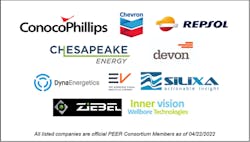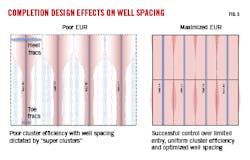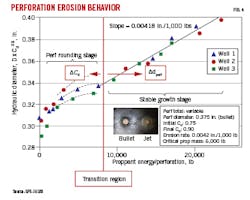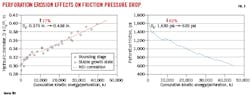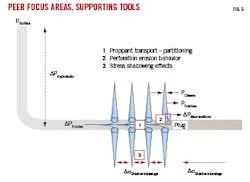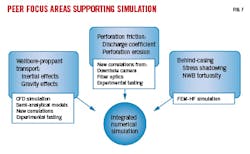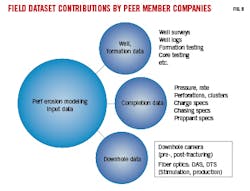Perforation erosion consortium studies limited entry treatments
Dante Guerra
NSI Technologies LLC
Tulsa, Okla.
A Perforation Erosion (PEER) Consortium is investigating perforation erosion in unconventional fracture limited-entry treatments. The consortium is led by NSI Technologies LLC (NSI) and brings together operators, downhole diagnostic companies, and service companies with the objective of collaboratively advancing the industry’s understanding of perforation erosion and its ability to accurately model the resulting effects and ultimately improve well performance.
Fig. 1 shows the target audience for PEER. A multidisciplinary consortium membership was envisioned from the start, to leverage respective strengths of each company. Participation by operators is critical, as most of the work to be conducted by PEER will depend on well datasets and supporting field diagnostics related specifically to completion evaluation.
The PEER consortium has eleven official members: five operators and six service companies (Fig. 2). The project is in the process of collecting and analyzing operator field-diagnostic datasets.
Limited entry
As frac job sizes have increased and well spacing decreased, adjacent well fracture treatments have begun to interfere with each other, most often leading to degraded well performance. Poor cluster efficiency leads to dominant or runaway fractures which can create fracture hits or fracture-driven interactions (FDIs) between new wells, or between legacy and infill wells.
There is an interdependency between well completion design and well spacing. With the tendency to reduce well spacing, cluster efficiency and stimulation uniformity become critically important. Fig. 3 illustrates this concept by showing two possible scenarios. The left side shows poor cluster efficiency or uneven stimulation along the lateral sections of the wells, leading to gaps of unstimulated (and therefore undrained) rock in the reservoir if a minimal overlap approach is taken to avoid FDIs. The right side illustrates good cluster efficiency and uniform stimulation along the laterals, improving well spacing and developing proper stimulation and drainage of the entire reservoir section.
The most common approach to improve cluster efficiency is limited entry, defined as limiting the number or diameter of perforations to uniformly distribute hydraulic fracturing treatments among multiple perforated intervals within an active fractured section (stage) of the well. Limited entry creates a desired level of perforation friction pressure-drop across each of the perforation clusters to overcome natural in situ stress differences along the lateral, and more importantly, differences in fracture net-pressure due to stress shadowing amongst multiple closely spaced fractures (OGJ, Aug. 3, 2020, pp. 23-28). This concept is not new. Its introduction and application to vertical wells can be credited to Royal Dutch Shell PLC in 1963.1
The biggest drawback to limited entry is perforation erosion, which occurs through two distinct processes. At the start of slurry pumping, inner sharp perforation edges become rounded, changing the general shape of the casing perforation from cylindrical to a cone or nozzle shape. This process changes the discharge coefficient (Cd). As the erosion process continues, the altered perforation uniformly erodes in contact with the slurry, leading to an increase in perforation diameter. This process was illustrated by Cramer after a series of tests that measured perforation erosion as a function of proppant mass (Fig. 4).2
To demonstrate the significant impact that perforation erosion can have on a limited-entry completion, NSI used the experimental perforation erosion measurements published by Cramer and applied updated correlations to model both the change in discharge coefficient and diameter growth as a function of cumulative kinetic energy (from the proppant, measured in kiloJoules, kJ), rather than proppant mass. Experimental data, replotted as a function of cumulative kinetic energy (Fig. 5, left), show that the initial perforation rounding stage (or change in discharge coefficient) follows a tighter pattern then when plotted as a function of proppant mass. The NSI correlation closely follows this pattern.
Modeled perforation erosion calculates limited entry pressure from perforation friction (Fig. 5, right). These results show that small changes caused by perforation erosion lead to large changes in limited-entry pressure. Using the example in Fig. 5, a 17% increase in perforation diameter led to a more than 62% loss of limited entry pressure.
Unknowns
Existing fracture modeling tools attempt to account for perforation erosion and the resulting effects on hydraulic fracturing stimulation to varying degrees. But to date there are significant assumptions applied in modeling perforation erosion which hinder accurate limited-entry pressure modeling throughout the fracture job. This is especially true with increasing stage lengths having larger numbers of clusters per stage. The predominant assumptions leading to these inaccuracies are:
- Proppant slurry concentration is constant across all treated clusters.
- All perforations in each cluster erode at the same rate (regardless of phasing).
These assumptions are not only used in fracture modeling tools, but also in interpretation and analysis of downhole diagnostics such as fiber optic distributed acoustic sensing (DAS) measurements, leading to possible errors in the resulting metrics. With DAS particularly, the acoustic signal generated by fluid and proppant slurry flowing across a perforation cluster is measured by responses in the fiber optic cable and is subsequently converted to a corresponding slurry flow rate.
The conversion from acoustic signal to flow rate necessarily requires knowledge of the cross-sectional flow area which comes from assumptions based on vendor-provided values or in some cases down-hole imaging diagnostics. This cross-sectional area is also changing during stimulation due to erosion. If not accounted for, these changes compound errors in interpreted flow rate allocation. The ability of DAS to accurately measure slurry distribution therefore is limited among multiple clusters within a stage.
Once flow rate distribution estimates are made among various clusters, there is a further problem in accurately determining how much proppant has been distributed to the various clusters. The most common approach is to assume a linear relationship between slurry volume and proppant volume (constant proppant concentration) regardless of cluster position within the stage (heel vs. toe). Although DAS has proven invaluable in advancing understanding of hydraulic fracturing stimulation, current knowledge gaps need to be addressed to improve technology and insights resulting from its application. PEER will advance understanding of three critical focus areas for completion design:
- Proppant transport and partitioning among multiple perforations and clusters.
- Perforation erosion.
- Stress interference or stress shadowing between multiple propagating hydraulic fractures in multistage horizontal wells.
Fig. 6 illustrates these three areas, referred to as the PEER Focus Areas. Fig. 7 shows supporting data that will be used to advance the understanding and description of each corresponding area.
Formation of the PEER Consortium stemmed from problems that arise when modeling new well completions without a proper understanding of slurry proppant transport, perforation erosion, and stress shadow between clusters. Current numerical simulation tools lack the ability to model these focus areas adequately. Increased availability of field diagnostics and monitoring data, coupled with high-frequency completion data, advanced experimental testing, and new data processing and interpretation will identify statistically significant trends and correlations to properly understand critical-area behaviors.
No single operator can collect all data and test enough completion and production strategies to identify efficiently the optimal development strategy within relevant time and cost constraints. The principal objective of PEER is to create a collaborative space to accelerate the learning curve in the three focus areas. This will be accomplished by leveraging existing field tests and corresponding diagnostic field measurements contributed to PEER by operator member companies, as well as the expertise and specialized technical services contributed by service company members, combined with advanced numerical modeling and software development and analytics. Fig. 8 shows examples of field datasets contributed by PEER Consortium member companies.
PEER will create a comprehensive database to include all field datasets and technical services provided as in-kind contribution by member companies. Existing operator members have committed more than 40 well datasets to date, with additional field diagnostic datasets to be acquired and contributed during the project. The proposed work will develop empirical correlations and physics-based models describing perforation erosion behavior as a function of modern completion variables, based on the evaluation and analysis of contributed field diagnostic measurements. These new correlations and models will be made available to member companies as stand-alone tools and coupled with numerical simulation within the StimPlan software suite.
All data collected by PEER will be catalogued and preprocessed to remove confidential, proprietary, or sensitive information before being included in the database and shared among consortium members. Unlike traditional consortia in which large fees are charged and accuracy and consistency of contributed data may be less than optimum, member companies to this consortium will determine the technical direction of PEER while also having input on the value of data contributed to PEER by future members.
Participation by downhole diagnostic companies (such as downhole imaging and fiber optic monitoring) and service companies (such as perforation charge manufacturers) further enhances the consortium’s capabilities by adding specialized resources, technology, and knowledge instrumental to the success of the project’s objectives.
The project will be divided into three phases, each scheduled for 1-year duration:
- Phase I, database creation and initial model buildout (currently underway).
- Phase II, experimental testing and model validation.
- Phase III, field testing and software integration.
Upon successful project completion, PEER Consortium member companies will have exclusive access to a comprehensive field monitoring and diagnostics database (compiled across multiple basins), and empirical, analytical, and physics-based models (provided as standalone tools) with integration into StimPlan frac-modeling software.
References
- Lagrone, K.W. and Rasmussen, J.W., “A New Development in Completion Methods – The Limited Entry Technique,” SPE-530-PA, Journal of Petroleum Technology, Vol. 15, No. 7, July 1, 1963, pp. 695-702.
- Cramer, D.D., “The Application of Limited-Entry Techniques in Massive Hydraulic Fracturing Treatments,” SPE-16189, SPE Production Operations Symposium, Oklahoma City, Okla., Mar. 8, 1987.
The author
Dante Guerra ([email protected]) is vice president of technical services at NSI. He holds a BS (2009) in mechanical engineering, an MS (2009) in mechanical engineering, and an MS (2009) in industrial engineering, all from The Ohio State University; and a PhD (2017) in petroleum engineering from Texas A&M University. He is a member of the Society of Petroleum Engineers (SPE).

